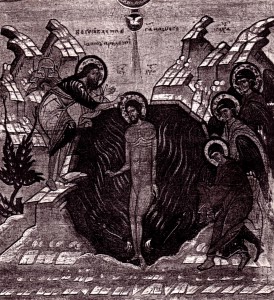The feast of Christ’s baptism is called “the Feast of Light,” linking baptism with illumination in a tradition too ancient to trace.
The apocryphal literature surrounding the New Testament is full of Jordan light imagery. The Gospel of the Ebionites reports that simultaneous with the voice of the Father, “a great light shone around about.” Among the church fathers, Ephrem the Syrian (early fourth century) writes: “The splendor of a light appeared on the water,” and Justin Martyr (second century) had already referred to baptism as enlightenment. McDonnell (Baptism, pp. 108-109) has a useful discussion of the light on the Jordan. Although the New Testament does not mention any unusual luminous phenomena at Christ’s baptism, all four evangelists do record that “the heavens were opened.” The Christian tradition has intuitively understood this to imply, among other things, a dramatic display of light shining down from heaven. The sixth-century composer of kontakia (chanted sermons), St. Romanos, interpreted the baptism of Christ poetically in terms of the manifestation of the divine light:
Today you have appeared to the inhabited world,
and your light, O Lord, has been signed upon us,
who, with knowledge, sing your praise, ‘You have come, you have appeared, the unapproachable Light.’
(Kontakia, On the Life of Christ, Translated by Ephrem Lash, San Francisco: HarperCollins, 1995, p. 39) The italicized words, “the unapproachable Light,” are the refrain that ends each stanza and unites the whole work.
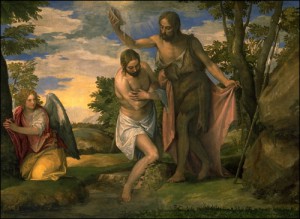 It is instructive in this case to begin our examination with later artistic interpretations, before returning to the classic icon tradition of the eastern church. Depicting the play of light on human forms was a major preoccupation of the Western tradition dating from the Renaissance, and it is among these artists that we find the most spectacular experiments with the light of the Jordan event. Giotto (about 1300) shows us a burst of light in the sky, but it does not cast any significant shadows from the figures below it.
It is instructive in this case to begin our examination with later artistic interpretations, before returning to the classic icon tradition of the eastern church. Depicting the play of light on human forms was a major preoccupation of the Western tradition dating from the Renaissance, and it is among these artists that we find the most spectacular experiments with the light of the Jordan event. Giotto (about 1300) shows us a burst of light in the sky, but it does not cast any significant shadows from the figures below it.
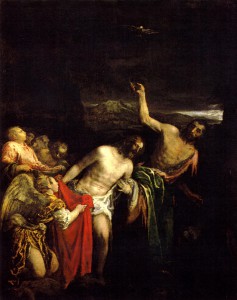 Similarly, Piero Della Francesca’s (about 1480) cool forms are delicately modelled with light and dark under a clear blue sky. The wide-open heavens in this case give off an impossibly even glow of enlightenment. Veronese (1561) paints pale white beams of light emanating from a kind of sunburst just outside the frame of the image, and John the Baptist catches this light on the top of his head and across his shoulders, leaving his body in pronounced shadow. A less famous artist, Jacopo Bassano (1592), renders the event memorably as a nocturne, represented in Paolo Berdini’s book, The Religious Art of Jacopo Bassano: Painting as Visual Exegesis. His canvas is so dark that all but the central forms are difficult to discern. In this painting, the presence of light in the darkness becomes not merely one element among others, but the central idea. Christ has entered the valley of the shadow of death, and seems almost to limp out of the Jordan. Baptism as death could hardly be made more plain: John holds his slender cross-staff, and at his feet a small lamb looks up at Christ. One of the angels is frozen in the act of throwing a large crimson cloak over Christ’s almost-naked body, while another looks upward, the only observer to see the approach of the dove. The all-important source of illumination is not, however, overhead; rather like stage light, it is somewhere in front of Christ, lighting his upper body and John’s raised arm.
Similarly, Piero Della Francesca’s (about 1480) cool forms are delicately modelled with light and dark under a clear blue sky. The wide-open heavens in this case give off an impossibly even glow of enlightenment. Veronese (1561) paints pale white beams of light emanating from a kind of sunburst just outside the frame of the image, and John the Baptist catches this light on the top of his head and across his shoulders, leaving his body in pronounced shadow. A less famous artist, Jacopo Bassano (1592), renders the event memorably as a nocturne, represented in Paolo Berdini’s book, The Religious Art of Jacopo Bassano: Painting as Visual Exegesis. His canvas is so dark that all but the central forms are difficult to discern. In this painting, the presence of light in the darkness becomes not merely one element among others, but the central idea. Christ has entered the valley of the shadow of death, and seems almost to limp out of the Jordan. Baptism as death could hardly be made more plain: John holds his slender cross-staff, and at his feet a small lamb looks up at Christ. One of the angels is frozen in the act of throwing a large crimson cloak over Christ’s almost-naked body, while another looks upward, the only observer to see the approach of the dove. The all-important source of illumination is not, however, overhead; rather like stage light, it is somewhere in front of Christ, lighting his upper body and John’s raised arm.
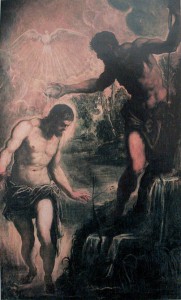 Bassano’s work may be the high point in thematic use of light for interpreting the baptism of Christ, but it is certainly not the only attempt. The slightly staged look of Bassano’s painting has almost come to dominate Tintoretto’s treatment of the scene. John and Jesus, two monumental figure-studies counter-poised to balance each other like parentheses, are strongly back-lit, so that thick black lines define their contours. Both of their faces, and most of John’s torso, are in shadow. The powerful light source is behind them, emerging from a tunnel-like opening in the dark clouds: the Holy Spirit’s emblematic dove hovers there, throwing rays of light in all directions. A secondary light source, like Bassano’s in front of the figures, catches the front of Christ’s body and parts of John’s pivoting figure. It is equally a matter of private judgment how effective and how affected this configuration proves to be. Powerful light from above was later recognized as a boon to artists working in graphic media; it provided the crisp shadows necessary for modelling forms with black lines. Rembrandt makes elegant and understated use of it in his little sketch, but in the hands of more pedestrian engravers it could become annoying and artificial.
Bassano’s work may be the high point in thematic use of light for interpreting the baptism of Christ, but it is certainly not the only attempt. The slightly staged look of Bassano’s painting has almost come to dominate Tintoretto’s treatment of the scene. John and Jesus, two monumental figure-studies counter-poised to balance each other like parentheses, are strongly back-lit, so that thick black lines define their contours. Both of their faces, and most of John’s torso, are in shadow. The powerful light source is behind them, emerging from a tunnel-like opening in the dark clouds: the Holy Spirit’s emblematic dove hovers there, throwing rays of light in all directions. A secondary light source, like Bassano’s in front of the figures, catches the front of Christ’s body and parts of John’s pivoting figure. It is equally a matter of private judgment how effective and how affected this configuration proves to be. Powerful light from above was later recognized as a boon to artists working in graphic media; it provided the crisp shadows necessary for modelling forms with black lines. Rembrandt makes elegant and understated use of it in his little sketch, but in the hands of more pedestrian engravers it could become annoying and artificial.

An altogether different, and rather original, treatment of light can be seen in the 1992 oil painting by Dutch artist Hans van Hoek, The Baptism in the Jordan. Here everything is flame, and the source of the fire seems to be the hovering Spirit, who has kindled the Jordan, the large tree, the river banks, and the three human figures. The Holy Spirit is revealed here in both of his emblems: the descending dove and the tongues of flame. Christ, who comes to baptize “with the Holy Spirit and with fire,” undergoes his own immersion in flame.
This theme of fire at Jordan could easily get out of control. McDonnell cites numerous early apocryphal references to fire at the Jordan, and extensive patristic developments (McDonnell, p. 106 ff). R. Alastair Campbell builds a solid exegetical case in “Jesus and His Baptism” (Tyndale Bulletin 47, November 1996, 191-214). He links John’s prophecy about baptism with fire and the Spirit; Jesus’ saying (Luke 12:49-50), “I came to bring fire to the earth…I have a baptism to be baptized with;” and the togetherness of fire and Spirit at Pentecost. Perhaps this image is also an allusion to the Elijah story, when “the fire of the Lord fell, and consumed the burnt offering, the wood, the stones, and the dust, and even licked up the water that was in the trench” (I Kings 18:38). John, the second Elijah, presides once more over the divinely-ordained sacrifice, and the true God is revealed in power.
How is the light of the “open heaven” depicted in the traditional icon of Christ’s baptism in the eastern churches? Unlike the more inventive images we have just examined, the light is not shown as an explosion, or a vast quantity of beams radiating in every direction, or as a strong source of illumination causing shadows to fall all around. It is shown as a single shaft of light, sharply delineated and confined to one narrow beam. It is sometimes white or another very light color, but no less often it is painted in dark blue, the same color as the Jordan below. The ray of light descends from the border at the very top of the image, down through the dove, to terminate at the cruciform nimbus of Christ. Linking up with the slender form of Jesus, the beam of light thus forms a strict vertical axis cutting the picture plane into two halves. This light is the axis of God’s decisive irruption into the world and history of humanity, intersecting our earthly reality “horizontally from above” (to use Karl Barth’s rhetoric). It links the Father in heaven with Jesus Christ on earth, through the Holy Spirit. The center of our icon is thus the Holy Trinity, and the divine economy of salvation.
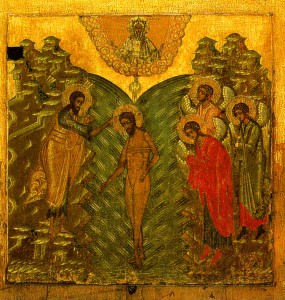 This compositionally decisive shaft of light was not present in the earliest representations of the scene. The vertical axis was actually established first, and the light took its place along that axis at a later period. In the baptisteries of Ravenna, the vertical axis is determined by the tall, central figure of Christ, and the dove diving straight downward toward him. John’s hand is interposed between them, and in the Baptistery of the Arians, a liquid flows from the dove’s beak to anoint Jesus. By the time of the middle Byzantine trio of monumental mosaic decoration (Nea Moni, Moni Daphni, and Hosios Loukas), the beam of light is a permanent part of the image.
This compositionally decisive shaft of light was not present in the earliest representations of the scene. The vertical axis was actually established first, and the light took its place along that axis at a later period. In the baptisteries of Ravenna, the vertical axis is determined by the tall, central figure of Christ, and the dove diving straight downward toward him. John’s hand is interposed between them, and in the Baptistery of the Arians, a liquid flows from the dove’s beak to anoint Jesus. By the time of the middle Byzantine trio of monumental mosaic decoration (Nea Moni, Moni Daphni, and Hosios Loukas), the beam of light is a permanent part of the image.
The baptism image shares this central stream of light with at least one other standard icon: The icon of Christ’s nativity. Directly above Mary and the swaddled Christ-child we see the same open heaven, the same strong vertical line, and midway down a circle in which is inscribed, not the dove of the Holy Spirit, but the Star of Bethlehem. Similar beams of light show up in the icon of Pentecost. Even more prominent are the beams of light in the icon of the Transfiguration, although in this case they come directly from Christ, and not from above him. I do not know if it is possible to reconstruct the history of icons precisely enough to determine which of these icons developed the light-beam motif first. The mere fact of their similarity is interesting enough, however, and suggestive. Ouspensky (Theology, vol. II, p. 398) cites the Orthodox rite of “the Blessing and Sanctification of the Icon of the Most Holy and Vivifying Trinity,” which allows for four possible iconic representations of the Trinity (and by its silence seems to disallow a number of other types already in use). The first of these is the angelic appearance to Abraham at Mamre, an image beyond the scope of this paper. The other three, however, are based on the economy of the Son, and depict New Testament events: Christ’s baptism, his Transfiguration, and Pentecost. These are exactly the images which we have noticed the beams of light in. The Annunciation, which also has a central beam of light, is to be interpreted theologically as a trinitarian event (the Father overshadowed Mary, the Spirit came over her, and Christ was conceived, Luke 1:35), but since there was no concrete visible or audible manifestation of the Father and Spirit there, it is not a Trinity icon.